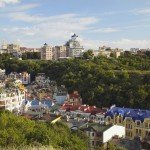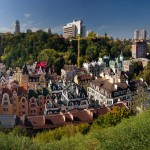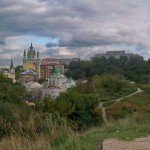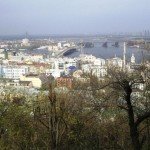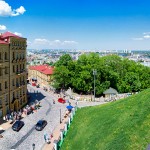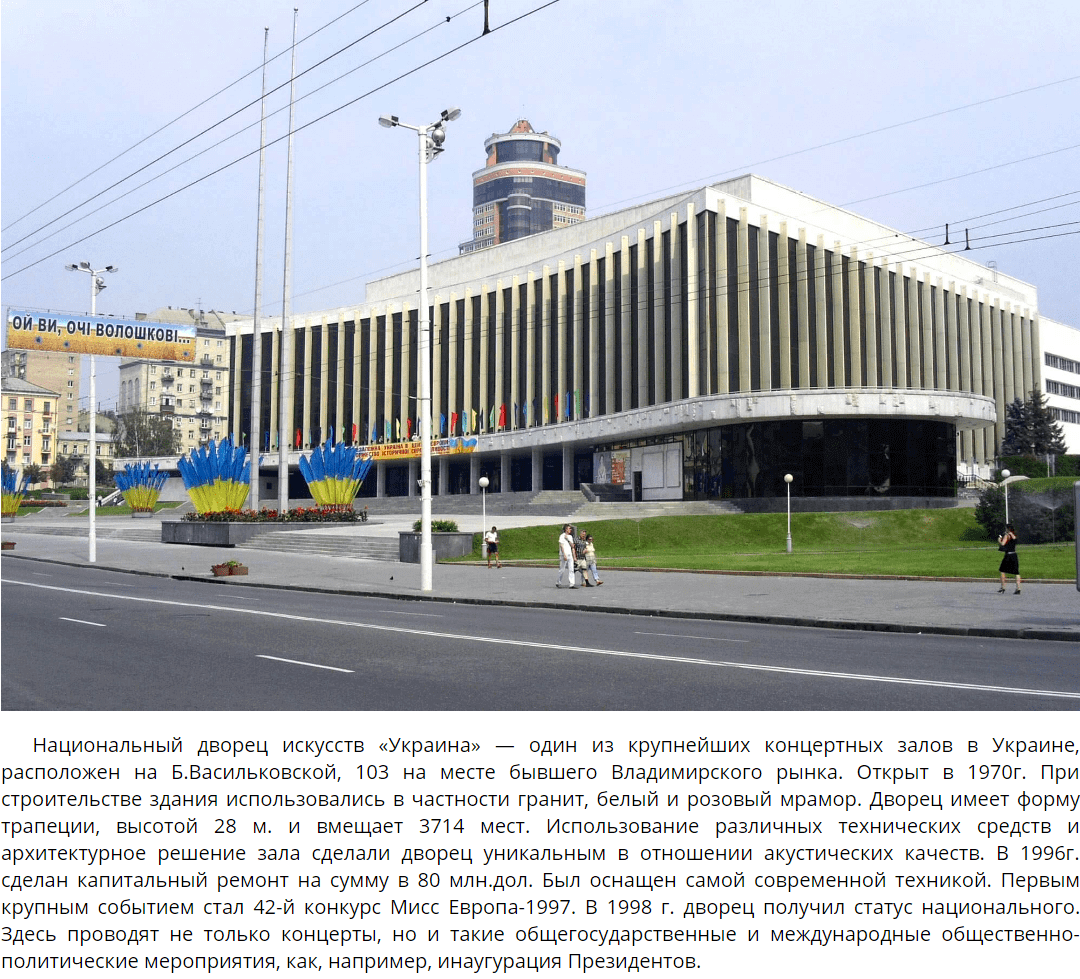View sites on the Andriivsky Descent
- Starokyivska Hill
- Detinka Hill
- Zamkova Hill
- Uzdykhalnytsia Hill
- View from the St. Andrew’s Church
– Starokyivska Hill – one of the central Kyiv hills, located in the Upper City. According to legend, Kyiv life was born in these places. Prince Kyi founded his city, as reminded by a memorable sign – a stone with inscribed words “Hence the land of the Rus appeared”. Presumably, in the north-western part of the modern Starokyivska mountain there was a “Kyi’s castle” – V-IX century. On the mountain, parts of the walls of the prince’s detynets and the foundation of the first stone church of Kyivan Rus laid by Prince Volodymyr – the Church of the Tithes (989-996) were partially preserved. Today on the Starokyivska mountain there is the Landscape alley – founded in the 1980s a viewing platform, where from the hillside there is a picturesque view of Vozdvyzhenka and Podil. Since 2009 sculptor K. Skretutsky began to decorate the Landscape alley with fabulous mosaic characters: centipede cats, elephant fountains, Alice in Wonderland, etc. And the Little Prince from the Saint-Exupery novel is a gift from the French Cultural Centre. In 2011 in the framework of the project “Kyiv fashion park”, 17 art objects were installed in the alley as a gift to the city. Today, the Landscape alley is under the protection of UNESCO.
– Detinka Hill – is a wedge shaped hill of Starokyivska Mountain, located near the natural boundary of Honchari-Kozhumyaky (from the Podil side). Presumably takes its name from the central fortification of Kyiv – Detynets, located at the foot of the mountain in the times of Kyivan Rus. Archaeological monuments of the Zarubintsi-Korchevat culture (III century BC – I-II centuries AD) were found at the Detinka hill. Remains of the Christian cemetery (XII-XIII centuries) were also found. The Detinka hill is mentioned in various historical documents. Thus, in the “Revision of the Castle of Kyiv” (XVI century), the hill is described as an important link in the fortified part of the city – Detynets. Today it is a protected area and Kyivans’ favourite place for leisure.
– Zamkova Hill – is a high hill with a history of several thousand years, was one of the central parts of Kyiv in the times of Kyivan Rus, fortified with defensive structures. Here was the handicraft district of the capital city. In the times of Kyivan Rus, the mountain was called Horyvytsia (also known as Kyselivka and Florovska), from the 15th century becomes Zamkova. The origin of the name is associated with the construction of a wooden castle built after the entry of Kyiv in 1363 into the Lithuanian Principality. There is a version that the fortifications were erected by the Kyivites in 1240 after Khan Batyi devastated Kyiv, destroyed the fortress on the Starokyivska mountain, which is nearby. In 1840, the Castle Hill is transferred to the Florovsky Convent under the cemetery. In 1921, the cemetery was closed, and with the outbreak of the Great Patriotic War in 1941, a military unit was placed on the Zamkova Hirka, which served the radio station, which was built here which was used to jam signals from foreign broadcasting stations. At the same time the military conducted to the mountain communication, finally destroyed the surviving sections of the old cemetery. In the 1990s the radio station for unnecessary dismantling, and the construction of the military unit was taken down for construction materials. Today, the hill is an ambiguous place, with which many legends and mystics are associated. Rising above the Dnipro on 80 m, from the Castle Hill offers an excellent view of Podil, Andriivsky Descent, St. Andrew’s Church and Vozdvyzhenka.
– Uzdykhalnytsia Hill – the most romantic hill of the capital. It was first mentioned in the middle of the 16th century. In the times of Kyivan Rus’ opposite the mountain was the military camp of the prince’s youngest retinue. According to the legend, the young ladies were not allowed to go there, but if one of them began to miss her beloved, she climbed the opposite hill, waved her lovely handkerchief, sighing and sending air kisses. So the hill became Uzdykhalnytsia . According to another version the name of the hill due to the fact that climbing this hill, people sighed with relief. Today the hill is a favourite place for tourists. On the hill there is a house – the Castle of Richard the Lionheart, the theaters “Academy” and “Wheel”, the Museum of one street and the M. Bulhakov Museum, an openind day in the open air, numerous exhibitions. Tourists are also attracted to the hill by the rumour that once it could be climbed through the secret passages and galleries Castle of Richard. Old-timers remember how, through the tunnels, staircases and galleries of Richard’s Castle, you could get to the top of the hill and enjoy an amazing view of Podil. Unfortunately, access to the famous house is closed today. But this is not an excuse to deny yourself the pleasure of discovering amazing places of power in Kyiv. The observation deck is led by a ladder from Richard’s Castle. From the Uzdykhalnytsia you can see the Castle Hill, the Dnipro, Podil, and the left bank of the capital. Now on the top of the hill has been held the festival of Ukrainian youth cinema “Open Night” for several years already.
– The St. Andrew’s Church – built by the order of Elizabeth the Empress as part of the Kiev royal residence, consisting of the Mariinskyi Palace and the palace church in 1749–1754 in the Baroque style designed by F.-B. Rastrelli. The temple is built on a steep spur of the Ancient Kiev Plateau, which served as a pedestal for the construction of the church. At this point, according to the chronicle “The Tale of Bygone Years”, in ancient times the mountain on which now the church stands was surrounded by the sea. Predicting the foundation of a large city, in the 1st century AD Andrew the First-Called the Apostle set a cross, and the water mysteriously retreated. According to a legend, now the church closes the underground sea, which can only be awakened by a bell ringing, triggering the second world flood. That is why, the bell tower was not built in the St. Andrew’s Church. Because of the location of the church on the top of the hill, its territory offers a panoramic view of the Andreevsky Descent and Podol.





